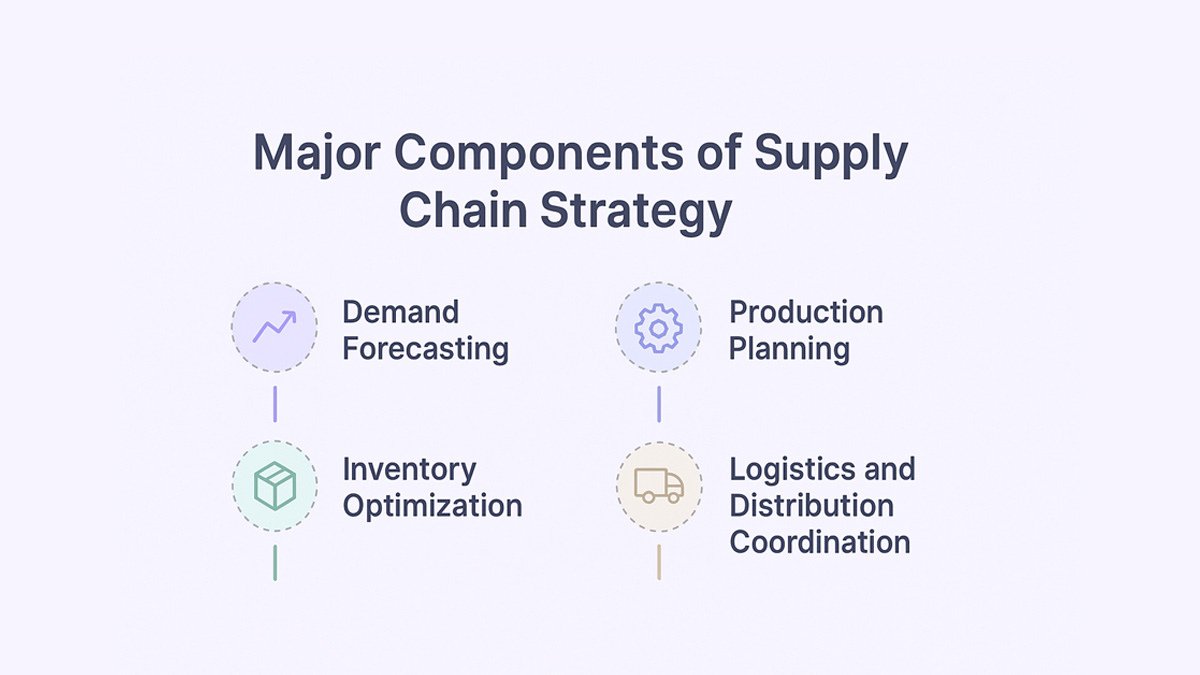

Mastering Modern Supply Chain Planning: A Practical Guide

Mastering Modern Supply Chain Planning: A Practical Guide
Explore modern supply chain planning strategies, tech trends, and challenges to build a smarter, more resilient operation.


According to McKinsey, nearly 75% of companies have faced supply chain disruptions in the past two years. Even a single delay whether from a port closure, a system outage, or a missing shipment can ripple across operations and hit revenue.
In today’s unpredictable market, traditional planning isn’t enough. Businesses need smarter, faster, and more connected ways to stay resilient and meet rising customer expectations.
What Is Supply Chain Planning Techniques
Supply chain planning techniques are methods businesses use to align demand, supply, production, and distribution efficiently. They help teams forecast needs, balance inventory, reduce delays, and improve coordination across people, processes, and technology for smoother operations.
Why Businesses Need to Rethink Their Supply Chain Planning Technique
The old playbook for supply chain planning doesn’t work in today’s fast-moving, disruption-prone world. Globalization, tech shifts, and customer demands have reshaped the landscape - and businesses that cling to outdated models risk falling behind. Expanding into a global market adds new variables like geopolitical risk and currency fluctuations.
Changing Customer Expectations
Today’s customers expect faster delivery, more personalization, and real-time updates. Meeting evolving customer needs requires responsive systems that adapt to buying behaviors and preferences. Traditional supply chains weren’t built for this level of responsiveness, making it necessary to adopt more agile, customer-centric planning models.
Global Disruptions and Uncertainty
From pandemics to geopolitical instability, global events can paralyze supply chains overnight. Rigid systems struggle to adapt, while modern approaches emphasize scenario planning and resilience to keep operations running during crises. Proactive risk management helps supply chains navigate uncertainty without compromising service levels.
Need for Real-Time Decision Making
Planning can no longer be done on spreadsheets updated once a quarter. Real-time data and AI-powered insights are now essential for making fast, informed decisions in a constantly changing environment.
Sustainability and Compliance Demands
Consumers and regulators are demanding greener, more ethical supply chains. Businesses must rethink their planning to include sustainable sourcing, energy-efficient logistics, and compliance tracking as core components - not afterthoughts. Building a sustainable supply chain is now a strategic imperative for long-term resilience. Staying compliant with global regulatory requirements also adds complexity to modern supply chain operations.
How Does Supply Chain Planning Actually Work?
Supply chain planning works by integrating data from across the business - sales, inventory, procurement, logistics - to create a coordinated roadmap for delivering products or services. Streamlining the supply chain process is key to eliminating friction between planning and execution. It typically starts with demand forecasting, followed by supply planning, production scheduling, and distribution planning. These steps are continuously monitored and adjusted based on real-time inputs like market shifts or supplier delays. The goal is to balance supply with demand while minimizing waste, avoiding stockouts, and keeping operations lean and agile.
Key Components of a Modern Supply Chain Planning Technique
A modern supply chain planning strategy is no longer a linear, once-a-year exercise - it’s dynamic, data-driven, and designed to adapt. At its core, it brings together several interconnected components that work in sync to ensure agility, cost-efficiency, and customer satisfaction.

Demand Forecasting
This is the starting point. Accurate forecasting uses historical data, market trends, and AI tools to predict what customers will want - and when. It’s equally important to factor in shifts in market demand caused by seasonality or external events. It helps prevent overstocking and understocking, which can both be costly.
Inventory Optimization
Too much inventory ties up capital. Too little leads to lost sales. Inventory optimization uses real-time visibility and analytics to strike the right balance, ensuring that stock levels match actual demand without excess. Effective inventory management ensures stock levels are aligned with both demand and storage capacity.
Production Planning
Production planning ensures that manufacturing resources are aligned with demand forecasts. Integrated capacity planning helps balance resource availability with forecasted workloads. It helps determine what to produce, in what quantity, and when - minimizing waste, managing labor, and improving throughput. Embracing lean practices supports continuous improvement across production and fulfillment stages.
Logistics and Distribution Coordination
This component focuses on getting the right products to the right place, at the right time. Businesses must also account for fluctuating lead times when coordinating logistics and distribution. It includes transportation planning, route optimization, and warehouse management - all critical to meeting delivery promises and reducing delays. Optimizing transportation costs is critical for maintaining profit margins in last-mile delivery. Strong logistics management ensures seamless coordination between warehouses and last-mile delivery.
Supply Chain Planning Techniques: Horizontal vs. Vertical Planning
Modern supply chains rely on both horizontal and vertical planning to stay agile. Each approach serves a different purpose across planning horizons from long-term strategy to short-term execution. Understanding how they complement each other helps businesses improve efficiency and respond faster to change.
Horizontal Planning: Strategic, Cross-Functional Alignment
Horizontal planning focuses on coordination across departments such as sales, marketing, finance, and operations. It looks at the bigger picture over a longer planning horizon often months or quarters ahead.
This approach ensures that every team works toward shared goals like demand forecasting, capacity planning, and budget alignment. By connecting business units early in the planning cycle, organizations can anticipate market shifts and make informed decisions before problems escalate.
Example: A company might align its sales forecasts with marketing campaigns and production targets to avoid overproduction or stockouts.
Vertical Planning: Tactical, Day-to-Day Optimization
Vertical planning operates at a more detailed and operational level. It focuses on short-term planning horizons, typically days or weeks and deals with execution tasks such as production scheduling, workforce allocation, and inventory control.
This type of planning ensures that the strategic goals set during horizontal planning are carried out efficiently. It connects planning with real-time data from shop floors, warehouses, and logistics teams.
Example: A manufacturing team might use vertical planning to adjust daily production schedules based on updated sales data or supply delays.
Top Challenges in Implementing Supply Chain Planning Techniques
Even with advanced tools and strategies, supply chain planning remains a high-stakes balancing act. Businesses face a range of obstacles that make forecasting, coordination, and execution more difficult often resulting in delays, cost overruns, and customer dissatisfaction.
Data Silos and Inconsistent Information
Challenge: When data is scattered across multiple systems and departments, it’s nearly impossible to get a clear view of demand, inventory, or supplier performance. The lack of centralized visibility leads to misaligned decisions and reactive planning. Weak supplier management often worsens the issue when vendor information isn’t unified.
Solution: Adopt centralized data management systems that consolidate supplier, demand, and inventory data in one place. This enables teams to plan collaboratively, track performance metrics in real time, and ensure that everyone from procurement to finance works from a single source of truth.
Poor Demand Forecasting Accuracy
Challenge: Unpredictable customer behavior, economic shifts, and market volatility make demand forecasting difficult. Relying on outdated models or manual estimates often results in excess inventory or product shortages both of which increase costs and reduce customer satisfaction.
Solution: Use predictive analytics and real-time demand signals to improve accuracy. AI-driven forecasting models can learn from historical trends and adjust to market fluctuations faster, giving businesses a clearer view of upcoming demand and helping them respond proactively.
Lack of Cross-Functional Collaboration
Challenge: Supply chain performance depends on tight coordination across sales, operations, finance, and procurement. However, siloed teams and unclear communication often lead to duplicated efforts, missed opportunities, and friction that slows decision-making.
Solution: Encourage shared planning cycles and unified KPIs across departments. Integrated collaboration platforms and planning dashboards allow cross-functional teams to align on priorities, improve accountability, and move toward common performance goals.
Inflexible Legacy Systems
Challenge: Many organizations still depend on legacy ERP systems that weren’t designed for modern supply chain demands. These systems are slow to update, difficult to integrate with newer technologies, and offer limited visibility into real-time data all of which limit agility.
Solution: Upgrade to flexible, cloud-based ERP or Advanced Planning and Scheduling (APS) systems that support integration, automation, and analytics. Modern solutions allow businesses to make faster decisions, gain full visibility into operations, and adapt quickly to changing conditions.
How Does Supply Chain Planning Fit in the SCOR Model?
The SCOR model short for Supply Chain Operations Reference breaks the supply chain into five key phases: Plan, Source, Make, Deliver, and Return. Each phase plays a distinct role in driving efficiency and visibility across operations.
Planning sits at the top of this framework as the first and most strategic function. It defines how resources, timelines, and goals will guide every subsequent phase. While the Plan phase focuses on demand forecasting, inventory targets, and production capacity, the remaining stages Source, Make, and Deliver are the execution layers that carry out what the plan defines.
- Plan: Sets the direction by aligning business goals with supply and demand forecasts. It establishes performance metrics, capacity plans, and risk controls.
- Source: Executes procurement based on the plan, ensuring the right materials and vendors are in place at the right time.
- Make: Converts sourced materials into finished products according to production schedules and quality standards.
- Deliver: Handles order fulfillment, logistics, and distribution to ensure products reach customers efficiently.
Emerging Technologies Shaping the Future of Supply Chain Planning
Modern supply chains aren’t just about moving goods - they’re powered by data, intelligence, and automation. Emerging technologies are redefining how businesses forecast demand, manage suppliers, and respond to disruptions.
Artificial Intelligence and Machine Learning
AI helps spot patterns in massive datasets - from customer orders to supplier behavior - to improve forecasting accuracy and decision-making. Machine learning models continuously evolve with new data, helping teams stay ahead of changing market conditions. Predictive analytics can further refine demand forecasts by anticipating consumer behavior shifts.
Digital Twins and Scenario Modeling
Digital twins are virtual replicas of the supply chain that allow businesses to simulate scenarios before making real-world changes. When combined with Internet of Things sensors, digital twins provide even deeper visibility into operations. From testing new routes to predicting disruption impact, they help de-risk decision-making.
Blockchain for Supply Chain Transparency
Blockchain ensures secure, transparent tracking of goods and transactions across the supply chain. It’s especially valuable in industries like pharma or food, where traceability and trust are essential.
Cloud-Based Planning Platforms
Legacy systems can’t keep up with the demands of real-time collaboration and data access. Cloud-based solutions offer flexibility, integration, and scalability - allowing distributed teams to plan and execute seamlessly from anywhere.
How Spendflo Helps With Supply Chain Planning and Control
When supply chain plans fall apart, it’s often because the systems and tools behind them don’t speak the same language. Disconnected SaaS platforms, scattered vendor data, and missed renewal windows can all lead to inefficiency and overspending, draining time and capital that should be driving growth.
That’s where Spendflo makes a measurable difference. One of our clients, a global SaaS company managing over 70 vendor contracts, reduced renewal delays by 40% and cut software costs by nearly 30% within the first quarter of using Spendflo. With centralized visibility and automated renewal tracking, their procurement team regained control and could finally plan with confidence.
Without structure and visibility, supply chain performance quickly becomes reactive. Spendflo brings both, helping teams align tech investments with strategic goals, avoid budget leaks, and focus on execution instead of chasing data.
Ready to see how Spendflo can simplify your supply chain planning and procurement? Book a demo today.
Frequently Asked Questions on Supply Chain Planning and Control
Mastering Modern Supply Chain Planning: A Practical Guide
Planning focuses on forecasting, scheduling, and coordination before execution, while management includes the broader process of overseeing and optimizing the entire supply chain from end to end.
How can technology improve supply chain planning accuracy?
Tech like AI, real-time analytics, and integrated cloud platforms enable better demand forecasts, faster adjustments, and smarter resource allocation based on real-time data. Advanced analytics can also uncover inefficiencies across the supply chain before they escalate.
What are the most common KPIs used in supply chain planning?
Key metrics include forecast accuracy, inventory turnover, order fulfillment rate, supply chain cycle time, and cost per unit delivered - all essential to measure efficiency and responsiveness. Choosing the right key performance indicators allows businesses to measure what truly matters.










.png)




.png)










.avif)





